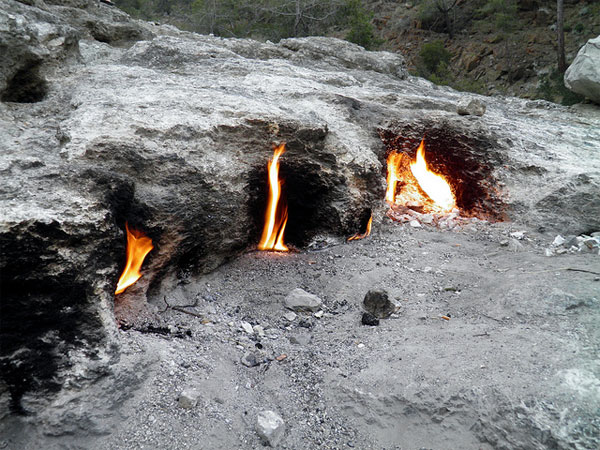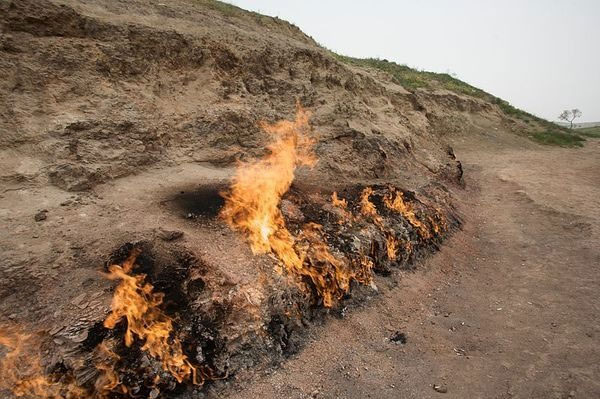The eternal flames of the world
Flames burn naturally in many areas of the world that have existed for decades or even centuries.
Hell Gate - Turkmenistan

Darvaza giant fire pit is located in the Karakum desert of Turkmenistan. In 1971, Soviet geological engineers accidentally created a fire pit when surveying the terrain here. Exploratory drilling has drilled an underground cave containing gas, causing engineers to set fire to prevent toxic metal leakage. However, the fire has not been extinguished as expected but has continued to burn for over 40 years.
Yanartas - Turkey

Yanartas is the area near the Olympus valley, southwestern Turkey, known for burning fires throughout the year. The fires in the valley burned continuously for at least 2,500 years, with the supposed cause of the rare metal Ruthenium.
Yanar Dag - Azerbaijan

Yanar Dag, also known as a fiery mountain, has a height of about 116m. This mountain is located on the Absheron peninsula, about 25km northeast of Azerbaijan's capital Baku. Unlike other mud volcanoes in Azerbaijan, the Yanar Dag does not produce mud or liquid, so the fire here always burns. A 10m long firewall around the mountain is almost never turned off. The fire can flare up to 3m high. Because fire burns all year round, the atmosphere is always full of gas.
Erta Ale - Ethiopia

"Fuming mountain" is the Afar name for the shield volcano 613m high, located in the desert of Ethiopia. Its notable point is the lava lake that operates on the hollow of the mountain's pan. According to scientists, this is a rare phenomenon and only 6 cases have been recorded on the planet. Erta Ale is the longest lava lake in the world.
Eternal fire - America

The fire is hidden behind the waterfall at Chestnut Ridge Park, New York. It is thought to form and burn light thanks to natural gas underneath the rock. The natural fire in New York is classified by rare scientists and a mystery to the scientific world.
Centralia Town - USA

Centralia, a town in the District of Columbia, Pennsylvania, used to be a living area of more than 1,000 residents. It turned into a "ghost town" after the fire from an uncontrolled coal mine made almost all of the people evacuated in 1984. The fire is said to have flared up since 1962, but must come A few decades later, people began to realize its tangible effects on their lives. Today, the population of this town is only about 10 people. Experts say the fire can burn 250 years.
Guanziling - Taiwan

The town of Guanziling in Tainan City is located on the fault line containing methane, the gas that normally escapes air through Earth's cracks. In this cave (photo), methane gas from hot water streams provides fuel to make the fire always on fire. According to a legend, the fire burned 300 years ago.
Baba Gurgur - Iraq

The oil field in Baba Gurgur is one of the largest areas in the world. It was discovered in the northern part of Iraq in 1927. In addition to providing energy, Baba Gurgur is also an important cultural and spiritual site for locals. In ancient times, expectant mothers often came here to pray for their children.
Flames in the coal field of Jharia, India

Coal mining here has been available since the late 1800s, the first fire was reported in 1920. From 1970 when coal mining companies shifted from underground mining to open-cast mining (making coal exposed). In oxygen-free air, the coal mine fires become serious.
Bituminous coal can even ignite itself at 40 ° C (104 ° F).
When the fire was big enough, they burned down the ground to make all houses, even the tracks were destroyed. In 1995, smoldering underground fire spread to the river bank to collapse the retaining wall, flooding the mining ground and killing 78 mine workers.
Fire in Jwalamukhi temple, India

There are many legends of natural flames, but there is no such a cruel Hindu legend about the eternal fire in Jwalamukhi temple. It is said that Prajapati Daksha humiliated her daughter Sati at a party, making the princess very sad and self-immolated to avoid being embarrassed.
In order to avenge the lover, the god of death, Daksha's beheaded Shiva and traveled around the world with the burnt body of her beloved lover. Finally, God Vishnu cut Sati's body into pieces and spread it all over the ground. Her tongue hit the Jwalamukhi temple and concentrated all her strength into a fire.
Therefore, the Jwalamukhi temple worships the Goddess of Light. The temple is located about 50 km from Dharamshala, India, when you come here, you can see blue flames burning by natural gas in the path to the mountain. In the temple there is no idol but only the fire is worshiped.

Underground coal mines create Mount Wingen volcano near the town of Wingen, New South Wales, Australia. The cause may be lightning or self-igniting coal. The people here said this mountain was burning continuously for 6000 years. Paleontologists believe this may be the longest burning phenomenon in history.
Each year the fire line spread about 1 meter to the south, this fire has spread at least 6km since it formed. At this rate, within 255,000 years it will spread to Sydney suburbs with a distance of 280km.
- Admire the world's most beautiful eternal fire
- Russia invents 'eternal' lamp
- The underground fire burned for 59 years in China
- The next 20 years will have eternal energy
- 10 great photos of permafrost
- The eternal kiss of the couple together for 2,800 years
- The unspeakable threat from the immortal fire of 6,000 years of smoldering does not turn off
- The truth about the process of
- The mystery of the thousand-year lights does not turn off
- The eternal tragedy of men
- The car was just walking on the water
- Why so many people believe that world gonna end?
 'Fine laughs' - Scary and painful torture in ancient times
'Fine laughs' - Scary and painful torture in ancient times The sequence of numbers 142857 of the Egyptian pyramids is known as the strangest number in the world - Why?
The sequence of numbers 142857 of the Egyptian pyramids is known as the strangest number in the world - Why? History of the iron
History of the iron What is alum?
What is alum?